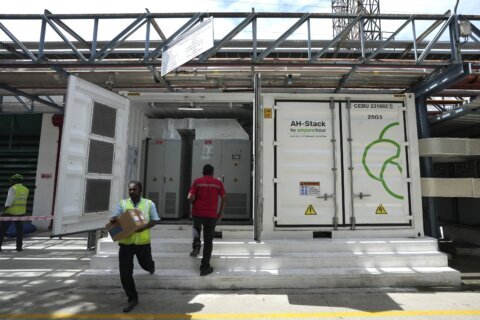Mortgage rates moved slightly higher this week, with the average 30-year fixed rate inching up to 6.94% from 6.92% the previous two weeks. Interest rates rose or stayed about the same across most home loan products, including fixed-rate and adjustable-rate mortgages.
Here are the current mortgage rates, without discount points unless otherwise noted, as of May 11:
— 30-year fixed: 6.94% (up from 6.92% a week ago).
— 20-year fixed: 6.8% (up from 6.78% a week ago).
— 15-year fixed: 6.25% (up from 6.22% a week ago).
— 10-year fixed: 6.33% (up from 6.32% a week ago).
— 5/1 ARM: 5.75% (equivalent to 5.75% a week ago).
— 7/1 ARM: 5.87% (up from 5.86% a week ago).
— 10/1 ARM: 6.13% (up from 6.1% a week ago).
— 30-year jumbo loans: 7.03% (equivalent to 7.03% a week ago).
— 30-year FHA loans: 5.96% with 0.06 point (equivalent to 5.96% a week ago).
— VA purchase loans: 6.22% with 0.04 point (up from 6.17% a week ago).
“While inflation remains elevated, its rate of growth has moderated and is expected to decelerate over the remainder of 2023. This should bode well for the trajectory of mortgage rates over the long term.”
— Sam Khater, Freddie Mac’s chief economist, in a May 11 statement
As forecasters have tried their best to parse economic data to determine future mortgage rate trends, one indicator has reigned above all others in shaping their projections: inflation. April’s consumer price index report showed that inflation continued to decelerate to a pace of 4.9% annually, which is down from 5% in March but still well above the Federal Reserve’s 2% target.
Additionally, inflation was up 0.4% month over month in April after seasonal adjustment, higher than the 0.1% monthly rate recorded in March. Although inflation seems to still be on the right track for the longer-term annual metric, this suggests a slight uptick in the monthly rate of price acceleration.
“While the U.S. economy is moving in the right direction, the pace of improvement is likely slower than desired by the Federal Reserve, and inflation still remains significantly above the target of 2%,” says Realtor.com economist Jiayi Xu. “In addition, although the labor market figures are promising amidst concerns of a recession, it also gives the Fed little reason to cut rates in the short term.”
As has been the case for many months, the cost of rent continues to keep inflation up. The rental index showed prices up 8.8% annually in April, and they’ve been holding steadily high for the past three consecutive months. Rental inflation is expected to slow given robust apartment construction to satiate high demand, but overall inflation will continue to be propped up by that significant shelter cost.
Other rent cost indexes have already shown price decreases, but the adjustment hasn’t yet shown up in the consumer price index. The Zillow Observed Rent Index shows that annual rental inflation was 5.3% in April after falling gradually from the peak of 16.9% in February 2022.
Next month, we’ll get some more data from the Fed that shows its predictions for inflation, employment and the federal funds rate, giving us a “clearer picture” of where mortgage rates are headed next, Xu says.
[Compare: Compare Mortgage Rates]
Indicator of the Week: A Looming Credit Crunch
Following high-profile bank failures including the collapse of Silicon Valley Bank, lenders have begun to tighten their balance sheets in order to reduce risk. Credit tightening means it may be harder for borrowers to qualify for some types of loans, including mortgages.
For the majority of borrowers who need a conforming conventional loan or a government-backed loan from the Federal Housing Administration, a credit crunch won’t change conditions too much. But for homebuyers who need a jumbo loan — a type of mortgage that’s typically held on bank balance sheets — it could become more difficult to qualify.
Especially when it comes to jumbo loans, lenders may implement stricter requirements for credit scores, debt-to-income ratio and loan-to-value ratio (in other words, down payment amounts). Plus, borrowing costs for these types of nonconforming mortgages are likely to rise. Jumbo loan rates have already begun to rise at a faster pace than conventional 30-year fixed rates.
Here are a few tips for qualifying for a mortgage in a credit crunch:
— Work on improving your credit score before you apply for a mortgage, such as by reducing your credit card debt or improving your on-time payment history.
— Find ways to lower your debt-to-income ratio, either by paying down existing debts such as an auto loan or by increasing your income.
— Save up more money for a down payment to reduce the loan amount you need to borrow and lower the LTV ratio on your mortgage.
— Consider buying a home within the conforming loan limit of your area to avoid the need to borrow a jumbo loan. The current CLL for most areas of the country is $726,200 or up to $1,089,300 in areas with a high cost of living.
— Apply through multiple mortgage lenders, including banks and credit unions. Keep your mortgage shopping within a two-week window to avoid multiple hard inquiries on your credit report.
Still, experts say that credit tightening isn’t the biggest hurdle facing homebuyers this year. Affordability and lack of inventory will remain to be the main challenges for today’s home shoppers.
[Calculate: Use Our Free Mortgage Calculator to Estimate Your Monthly Payments.]
More from U.S. News
What FHFA’s New Pricing Adjustment Means for Your Mortgage Rate
Spring Mortgage Forecast: Rates Will Stay Above 6%
Two-Thirds of Homebuyers Are Holding Out for Lower Rates
Mortgage Rates Inch Higher After Mixed Inflation Report originally appeared on usnews.com







